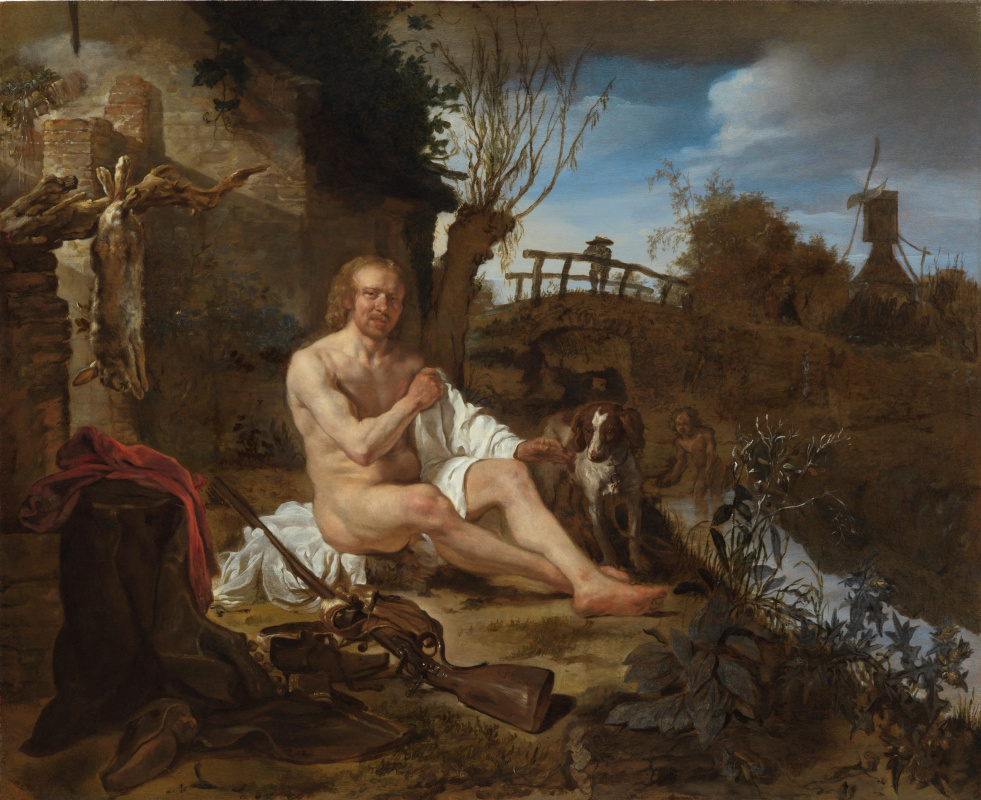log in
Enter site
Login to use Arthive functionality to the maximum
A Hunter Getting Dressed after Bathing
Gabriël Metsu • Painting, 1656, 51.7×63.8 cm
Description of the artwork «A Hunter Getting Dressed after Bathing»
In one of the most outstanding and unexpected Dutch paintings, Gabriël Metsu depicted himself sitting naked putting on his shirt. He openly smiles as if an actor in front of the audience. A gun, a horn for gunpowder, and a dead hare on the branch make it clear that the artist bathed after a successful hunt. A faithful dog is waiting for him, at a distance the artist depicted another swimmer, a walking couple and a man who was watching the scene from the bridge. The landscape, most likely, is a figment of the artist’s imagination, though it resembles the surroundings of Leiden.
The Netherlands are famous for an abundance of water, but a surprisingly small number of paintings depicts bathers. It seems that swimming was not a regular pastime for the Dutch. Water in the city channels was dirty, and in rural areas people refrained from taking a bath for fear of catching the infection.
One more artist besides Metsu who made a bather the main subject of his picture was Gerrit Dou. The "Bather" from the State Hermitage is so similar thematically to the portrait of Metsu that there is an idea that she the artist had the Dou’s painting as a starting point. In fact, “The Hunter” had been painted almost 10 years earlier than “The Bather”. Moreover, the classic image of Dou, depicting a soldier who points into the distance, is markedly different from the Metsu’s smiling subject. The painter did not try to hide his bodily flaws and gave his hunter a portrait character.
The comparison with the artist’s "Self-portrait at the window" confirms that Metsu portrayed himself in this work. It is difficult to understand why the artist did it in such an unusual manner. Dutch painters often showed hunters as passionate personalities who were fascinated by the pursuit of prey, whether animals or women. The phallic form of their long-barreled rifles often served as a visual symbol of masculinity. Metso even put his signature on the gun butt.
Artists also used a play of words to indicate the lustful thoughts. For example, the verb vogelen (literally, "catching bird") meant also the intercourse. In the paintings of Metsu and his fellow artists one can often see men who offer birds to women. The expression "rabbit hunt" was also a metaphor for sexual contact, although it was used less frequently.
Thus, the painter represented himself as a horny macho with a naked muscular body and a smile that emphasizes his arrogant masculinity.
You may decide that Metsu painted it as a personal joke. But the picture was likely to have been purchased during his lifetime or immediately after the artist’s death. The inventory of the English trader Thomas Maiden, who lived in Amsterdam and died in 1692, says «Metsu’s Bather” that must have been the "Hunter Getting Dressed after Bathing". Now this portrait is in the "Leiden collection" of the American billionaire Tom Kaplan.
Written by Vlad Maslov
The Netherlands are famous for an abundance of water, but a surprisingly small number of paintings depicts bathers. It seems that swimming was not a regular pastime for the Dutch. Water in the city channels was dirty, and in rural areas people refrained from taking a bath for fear of catching the infection.
One more artist besides Metsu who made a bather the main subject of his picture was Gerrit Dou. The "Bather" from the State Hermitage is so similar thematically to the portrait of Metsu that there is an idea that she the artist had the Dou’s painting as a starting point. In fact, “The Hunter” had been painted almost 10 years earlier than “The Bather”. Moreover, the classic image of Dou, depicting a soldier who points into the distance, is markedly different from the Metsu’s smiling subject. The painter did not try to hide his bodily flaws and gave his hunter a portrait character.
The comparison with the artist’s "Self-portrait at the window" confirms that Metsu portrayed himself in this work. It is difficult to understand why the artist did it in such an unusual manner. Dutch painters often showed hunters as passionate personalities who were fascinated by the pursuit of prey, whether animals or women. The phallic form of their long-barreled rifles often served as a visual symbol of masculinity. Metso even put his signature on the gun butt.
Artists also used a play of words to indicate the lustful thoughts. For example, the verb vogelen (literally, "catching bird") meant also the intercourse. In the paintings of Metsu and his fellow artists one can often see men who offer birds to women. The expression "rabbit hunt" was also a metaphor for sexual contact, although it was used less frequently.
Thus, the painter represented himself as a horny macho with a naked muscular body and a smile that emphasizes his arrogant masculinity.
You may decide that Metsu painted it as a personal joke. But the picture was likely to have been purchased during his lifetime or immediately after the artist’s death. The inventory of the English trader Thomas Maiden, who lived in Amsterdam and died in 1692, says «Metsu’s Bather” that must have been the "Hunter Getting Dressed after Bathing". Now this portrait is in the "Leiden collection" of the American billionaire Tom Kaplan.
Written by Vlad Maslov


